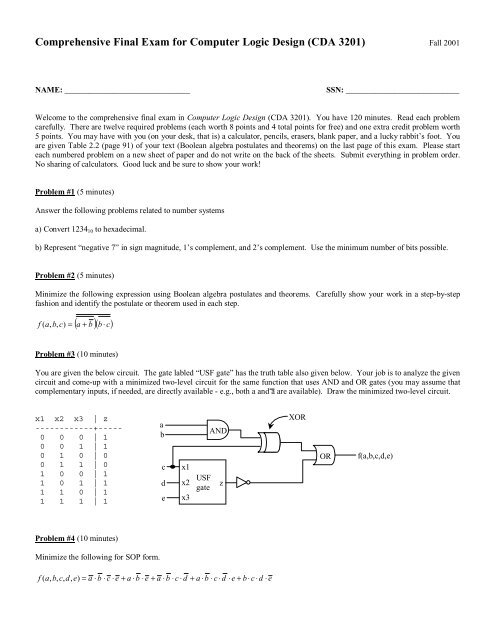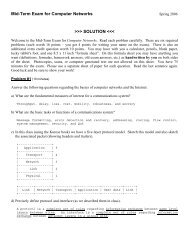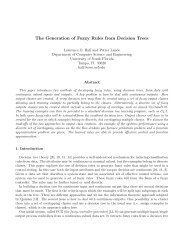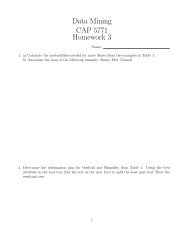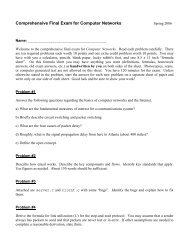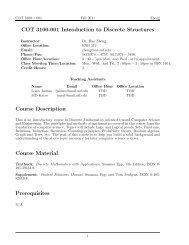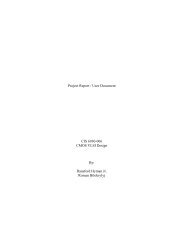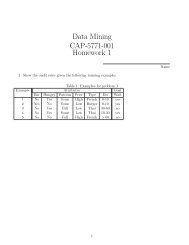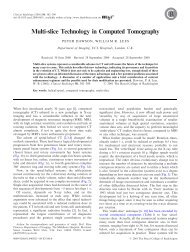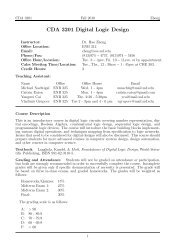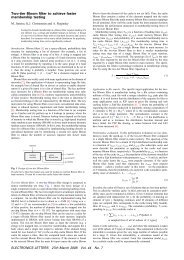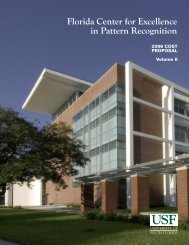Comprehensive Final Exam for Computer Logic Design (CDA 3201)
Comprehensive Final Exam for Computer Logic Design (CDA 3201)
Comprehensive Final Exam for Computer Logic Design (CDA 3201)
Create successful ePaper yourself
Turn your PDF publications into a flip-book with our unique Google optimized e-Paper software.
<strong>Comprehensive</strong> <strong>Final</strong> <strong>Exam</strong> <strong>for</strong> <strong>Computer</strong> <strong>Logic</strong> <strong>Design</strong> (<strong>CDA</strong> <strong>3201</strong>) Fall 2001<br />
NAME: _______________________________<br />
SSN: ____________________________<br />
Welcome to the comprehensive final exam in <strong>Computer</strong> <strong>Logic</strong> <strong>Design</strong> (<strong>CDA</strong> <strong>3201</strong>). You have 120 minutes. Read each problem<br />
carefully. There are twelve required problems (each worth 8 points and 4 total points <strong>for</strong> free) and one extra credit problem worth<br />
5 points. You may have with you (on your desk, that is) a calculator, pencils, erasers, blank paper, and a lucky rabbit’s foot. You<br />
are given Table 2.2 (page 91) of your text (Boolean algebra postulates and theorems) on the last page of this exam. Please start<br />
each numbered problem on a new sheet of paper and do not write on the back of the sheets. Submit everything in problem order.<br />
No sharing of calculators. Good luck and be sure to show your work!<br />
Problem #1 (5 minutes)<br />
Answer the following problems related to number systems<br />
a) Convert 1234 10 to hexadecimal.<br />
b) Represent “negative 7” in sign magnitude, 1’s complement, and 2’s complement. Use the minimum number of bits possible.<br />
Problem #2 (5 minutes)<br />
Minimize the following expression using Boolean algebra postulates and theorems. Carefully show your work in a step-by-step<br />
fashion and identify the postulate or theorem used in each step.<br />
f ( a,<br />
b,<br />
c)<br />
=<br />
( a + b )( b ⋅ c)<br />
Problem #3 (10 minutes)<br />
You are given the below circuit. The gate labled “USF gate” has the truth table also given below. Your job is to analyze the given<br />
circuit and come-up with a minimized two-level circuit <strong>for</strong> the same function that uses AND and OR gates (you may assume that<br />
complementary inputs, if needed, are directly available - e.g., both a and a are available). Draw the minimized two-level circuit.<br />
x1 x2 x3 | z<br />
------------+-----<br />
0 0 0 | 1<br />
0 0 1 | 1<br />
0 1 0 | 0<br />
0 1 1 | 0<br />
1 0 0 | 1<br />
1 0 1 | 1<br />
1 1 0 | 1<br />
1 1 1 | 1<br />
a<br />
b<br />
c<br />
d<br />
e<br />
x1<br />
x2<br />
x3<br />
USF<br />
gate<br />
AND<br />
z<br />
XOR<br />
OR<br />
f(a,b,c,d,e)<br />
Problem #4 (10 minutes)<br />
Minimize the following <strong>for</strong> SOP <strong>for</strong>m.<br />
f ( a,<br />
b,<br />
c,<br />
d,<br />
e)<br />
= a ⋅ b ⋅ c ⋅ e + a ⋅ b ⋅ e + a ⋅ b ⋅ c ⋅ d + a ⋅b<br />
⋅ c ⋅ d ⋅ e + b⋅<br />
c ⋅ d ⋅ e
Problem #5 (10 minutes)<br />
Implement the truth table given below using a 3-to-8 decoder, an 8-to-1 multiplexer, and a 4-to-1 multiplexer (you should have<br />
three implementations shown in your answer). A “dc” is a don’t care.<br />
A B C | f<br />
----------+---<br />
0 0 0 | 1<br />
0 0 1 | 0<br />
0 1 0 | 0<br />
0 1 1 | dc<br />
1 0 0 | 1<br />
1 0 1 | 1<br />
1 1 0 | dc<br />
1 1 1 | 0<br />
Problem #6 (5 minutes)<br />
Give the truth table <strong>for</strong> a binary full-adder and then implement using any kind of basic gates (NOT, AND, OR, XOR) that you<br />
want.<br />
Problem #7 (5 minutes)<br />
Sketch an SR NOR latch and correctly label all inputs and output. Give the next state table. Identify any illegal inputs. Show how<br />
this illegal input condition can be “fixed” (you may not simply assume that the illegal inputs will never occur).<br />
Problem #8 (10 minutes)<br />
Using T latches and basic gates, design a counter that counts in the following sequence, 000, 100, 010, 101, 111, and repeats the<br />
seqeunce.<br />
Problem #9 (15 minutes)<br />
Analyze the following synchronous sequential circuit. You are to give the state diagram <strong>for</strong> this circuit.<br />
x<br />
AND<br />
z<br />
y 2<br />
y 2<br />
Q<br />
Q<br />
J<br />
K<br />
clock<br />
y 1<br />
Q<br />
D
Problem #10 (20 minutes)<br />
Given the state diagram below, design a synchronous sequential circuit using D flip-flops to implement it. Your implementation<br />
must have a minimum number of flip-flops and a “good” state assignment. Carefully show your work including the state<br />
assignment procedure. You need not draw the final circuit, simply giving the excitation equations <strong>for</strong> the D flip-flops and the<br />
output equation is sufficient.<br />
Problem #11 (10 minutes)<br />
Give a state diagram <strong>for</strong> a synchronous sequential ciruit to detect a start of a message sequence of 11 or 001. That is, when the<br />
circuit is reset, it outputs a 1 when the sequence 11 or 1001 is first detected. The input sequence is synchronous with a clock<br />
source. A black box view of the circuit is show below.<br />
reset<br />
message bits<br />
Sequence<br />
detector<br />
output<br />
clock<br />
Problem #12 (10 minutes)<br />
Answer the following questions about pulse-mode and fundamental-mode sequential circuits.<br />
a) What is a pulse-mode sequential circuit Carefully describe the attributes of such a circuit comparing it to a synchronous<br />
sequential circuit.<br />
b) What is a fundamental-mode sequential circuit Carefully describe the attributes of such a circuit comparing it to<br />
synchronous and pulse-mode sequential ciruits.<br />
c) When would you use a pulse-mode or fundamental-mode sequential circuit instead of a synchronous sequential circuit State<br />
at least two good reasons.<br />
Extra Credit (5 minutes)<br />
Give three practical ideas <strong>for</strong> improving the class (not including the lab in this case). For full credit, the ideas must not entail<br />
additional resources or reducing the content of the course. General complaints or rants will not help me or future students very<br />
much.
---


